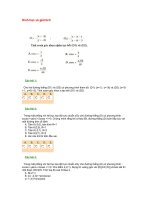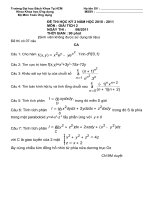Giai tich 2 nam2016
Bạn đang xem bản rút gọn của tài liệu. Xem và tải ngay bản đầy đủ của tài liệu tại đây (191.37 KB, 4 trang )
BÀI TẬP LỚN MÔN GIẢI TÍCH 2 LỚP D15
Chú ý: h là số thứ tự trong bảng danh sách điểm danh; m là số dư của phép chia h cho 20; k = m + 1 .
k, h
SV phải ghi số thứ tự h sau tên họ của mình. Phải thay
bằng số thứ tự trước khi tính toán.
--------------------------------------------------------------------------------------------------------------1) Find the indicated derivative for each of the following functions.
a) Find
f xxyzz
b) Find
f xxy
3 2
for f ( x, y, z ) = hz y ln(kx)
kxy
for f ( x, y ) = e .
∂z
∂z
2
2
2r
2
2) Find ∂s and ∂t for z = e sin(kϕ ) , r = st − t , ϕ = s + t
.
∂f ∂f ∂f
∂f ∂f ∂f
,
,
, ,
∂
r
∂
θ
∂
ϕ
∂
x
∂y ∂z , where ( r , θ , ϕ ) are spherical coordinates.
3) Express the derivatives
in terms of
4) Jessica and Matthew are running toward the point P along the straight paths that make a fixed angle of
θ (Figure 3). Suppose that Matthew runs with velocity va m / s and Jessica with velocity vb m / s .
Let f ( x, y ) be the distance from Matthew to Jessica when Matthew is x meters from P and Jessica is y
meters from P.
a) Show that
f ( x, y ) = x 2 + y 2 − 2 xy cos θ
.
π
3 . Use the Chain Rule to determine the rate at which the distance between
b) Assume that
v =4 m/s
v =3 m/s
Matthew and Jessica is changing when x = 30, y = 20, a
and b
.
θ=
5) Find each of the directional derivatives.
∂f
2π
r
uur (2,0)
θ=
xy
3
a) ∂u
where f ( x, y ) = xe + ky and u is the unit vector in the direction of
∂f
r
uur ( x, y, z )
2
3 2
f
(
x
,
y
,
z
)
=
x
z
+
y
z
−
kxyz
v
b) ∂v
where
in the direction of = ( −1,0,3) .
6) (Estimating Change: Body Mass Index; BMI is one factor used by health care professionals to
assess the risk of certain diseases such as diabetes or high blood pressure, The range 18.5 ≤ I ≤ 24.9 is
considered normal for adults over 20 years of age)
W
I= 2
H , where W is the body weight (in kilograms) and H is the body
A person's Body Mass Index is
height (in meters). The Body Mass Index (BMI) for a child of mass W = 17 kg and height H = 1.05 m is
I = 17 /1.052 ≈ 15.4 . Estimate ∆I if (W, H) changes to (18.5, 1.07).
7) Find the critical points of the function. Then use the Second Derivative Test to determine whether they
are local minima or maxima (or state that the test fails).
a)
f ( x, y ) = 3x 2 y + y 3 − 3x 2 − 3 y 2 + h .
3
4
2
b) f ( x, y ) = x + y − 6 x − 2 y + k
.
8) Determine the global extreme values of the function on the given domain.
a)
f ( x, y ) = x3 + x2 y + 2 y 2 + h, x, y ≥ 0, x + y ≤ 1
2
2
b) f ( x, y ) = (4 y − x )e
− x2 − y2
2
.
2
+ k, x + y ≤ 2
.
9) Find minimums and maximums of f ( x, y, z ) = 4 y − 2 z subject to the constraints 2 x − y − z = 2 and
x2 + y 2 = 1 .
10) Evaluate the following integrals by first reversing the order of integration.
3 9
a)
∫ ∫ hx e
0x
3 y3
dydx
2
8 2
b)
∫∫
0
3
x 4 + 1dxdy
y
2
2
2
11) Determine the volume of the region that lies under the sphere x + y + z = 9 , above the plane
2
2
z = 0 and inside the cylinder x + y = 5 .
12) Evaluate
∫∫∫
x 2 + y 2 + z 2 dxdydz
V
, where V is the region bounded by the plane z = k and the cone
z = x2 + y 2
x2 y2
+
=1
9
13) Evaluate W
, where W is the domain bounded by the elliptic cylinder 4
, the
2
2
2
sphere x + y + z = 16 in the first octant x ≥ 0, y ≥ 0, z ≥ 0 (Figure 15).
∫∫∫ hydxdydz
14) Describe a region whose volume is equal to:
2π π /2 9
a)
∫ ∫ ∫r
0
sin ϕ drdϕ dθ
0 4
1 π /4 2
b)
2
∫ ∫ ∫ rdrdϕ dz
−2 π /3 0
2π 3
c)
0
∫∫ ∫
0 0 − 9− r
rdϕ dzdr
2
2
15) Convert to spherical coordinates and evaluate:
16) Calculate
∫ ( x + y + hz )ds
C
4− x 2
∫ ∫
−2 − 4− x 2
4− x 2 − y 2
∫
e− k ( x
2
+ y 2 + z 2 )3/ 2
dxdydz
0
.
,
where C is the helix c (t ) = (cos(t ),sin(t ), t )
for 0 ≤ t ≤ π (Figure 3).
17) Verify that the following vector field has a potential function ϕ and find one:
ur 2 xy
x2
x2 y
F =
,z + ,y − 2 ÷
z
z ÷
z
.
ur ur
ur
F
=
∇
ϕ
18) Verify that
and evaluate the line integral of F over the given path:
ur
1 2 2
F = xy 2 , x 2 y ϕ ( x, y ) = x y
2
a)
,
; upper half of the unit circle centered at the origin oriented
(
)
counterclockwise.
ur z
z
F =
,
,ln( x − y ) ÷
2
2
x− y y−x
, ϕ ( x, y, z ) = z ln( x − y ) ; ellipse 2 x + 3( y − 4) = 12 in the
b)
clockwise direction.
19) Calculate the surface integral
∫∫ ( z − x)dS
S
,
2
where S is the portion of the graph of z = x + y
where 0 ≤ x ≤ y ≤ 1 (Figure 14).
ur
20) Compute surface integrals of vector fields F for the given oriented surface .
ur
F ( x, y, z ) = y, x 2 y , e xz x 2 + y 2 = 9
a)
,
, −3 ≤ z ≤ 3 , outward-pointing normal
ur
F ( x, y, z ) = 0,0, xze xy z = xy 0 ≤ x, y ≤ 1
b)
,
,
, upward-pointing normal
(
(
)
)
c)
(
ur
2
F ( x, y , z ) = x 2 − z 2 , e z − cos x, y 3
octant, outward-pointing normal.
) , x + 2 y + 4z = 12 and the coordinate planes in the first









